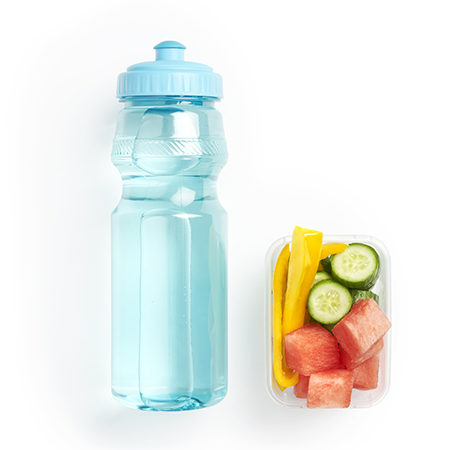About Crunch&Sip
Crunch&Sip is a primary school nutrition program, developed to increase the amount of vegetables, fruits and water being consumed by Western Australian children. It is an easy way to help kids stay healthy and happy during class time!

Crunch&Sip is a set time during the school day for students to eat vegetables and fruit and drink water in the classroom. The Crunch&Sip break is not designed to replace recess and must occur within class time. Students bring vegetables and/or fruit in a reusable container and a clear water bottle to school each day for the Crunch&Sip break.
Giving students the chance to re-fuel in class with fruit or vegetables helps to improve physical and mental performance and concentration, as well as promoting long term health.
Crunch&Sip is a well-established program in Western Australia, with over 50% of eligible schools across the state currently certified.
The objectives of Crunch&Sip are to:
- Increase awareness of the importance of eating vegetables and fruit and drinking water
- Provide students, teachers and staff an opportunity to eat vegetables and fruit in the classroom during Crunch&Sip time
- Encourage students, teachers and staff to drink water in the classroom throughout the day, during break times and at sports, excursions and camps
- Improve the nutrition knowledge, attitudes and behaviours, among parents and community members
- Increase the proportion of Western Australian primary schools implementing the Crunch&Sip program.
Why should students eat vegetables and fruit in class?
Australian kids aren't eating enough vegetables and whole fruit. Government research shows that:
- Only one in sixteen eat the recommended daily serves of vegetables
- Over seven in ten eat the recommended daily serves of fruit
Crunch&Sip helps children to develop regular healthy eating habits by providing a set time in class to develop healthy habits. Eating a healthy diet in childhood reduces the risk of becoming overweight or obese. The proportion of children carrying excess weight has more than doubled in the last 30 years, with one in four Western Australian children now overweight or obese. Being overweight or obese increases your risk of developing chronic diseases, such as heart disease, type 2 diabetes and some cancers, later in life.
Why should students drink water in class?
Water lost each day through breathing, sweating and going to the toilet needs to be replaced. Not drinking enough fluid results in dehydration which can lead to the reduced ability to concentrate, headaches and irritability. By the time a person is thirsty, they are already becoming dehydrated.
Children rarely drink enough during break times at school and often forget to drink unless reminded. Some teachers comment that they always let students leave the class to have a drink from a fountain if they ask permission. But children may not think to ask, and other students can use 'going for a drink' as an opportunity to 'go for a wander'.
Students who are regularly reminded to drink water and who are able to bring a water bottle into the classroom drink more and are less likely to become dehydrated.
Evaluation
Barnes, Roseanne. 2010. Crunch&Sip Policy Evaluation: Results of the Audit Survey and Tally Charts.
Healthway. Case study: Fruit and Water Policy in School Pilot Project.
History
Crunch&Sip was adapted from the Great Southern Public Health Service and the Albany and Narrogin District Education Offices Fruit & Water Policy in Schools Project. Healthway funded the pilot project in 6 primary schools located in the Great Southern region in 2000. In 2002, the Western Australian Minister for Health acknowledged the success of the project with the presentation of the Healthway 'Excellence in Health Promotion Award' to the Nutrition Program at the Great Southern Public Health Service.
The Crunch&Sip program was launched to all Western Australian primary schools in 2005 with funding provided by the Department of Health as part of the Go for 2&5 campaign. From 2006, the program has been coordinated by Cancer Council WA. From late 2011 until June 2015, funding was provided under the National Partnership Agreement on Preventive Health.
Healthway currently funds the Crunch&Sip program. As part of the new funding arrangement, Crunch&Sip is evolving to have a stronger focus on the promotion of vegetables. While students can still bring fruit, vegetables are promoted as the snack of choice for Crunch&Sip breaks.